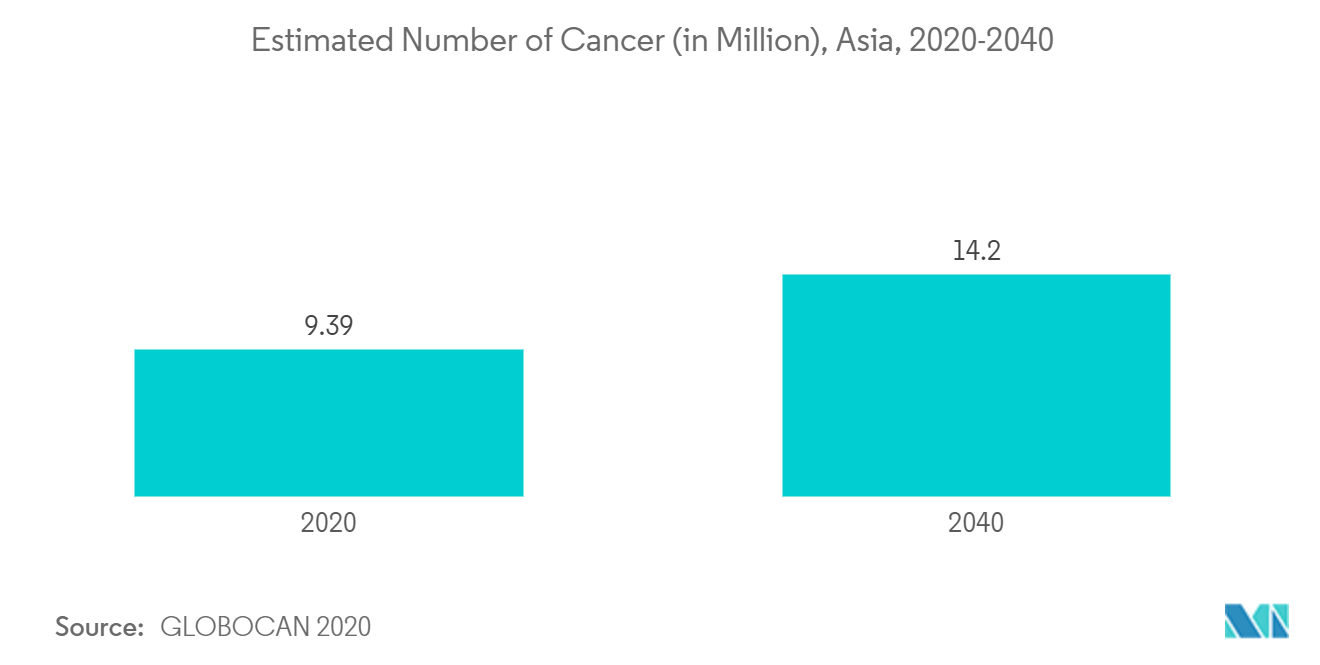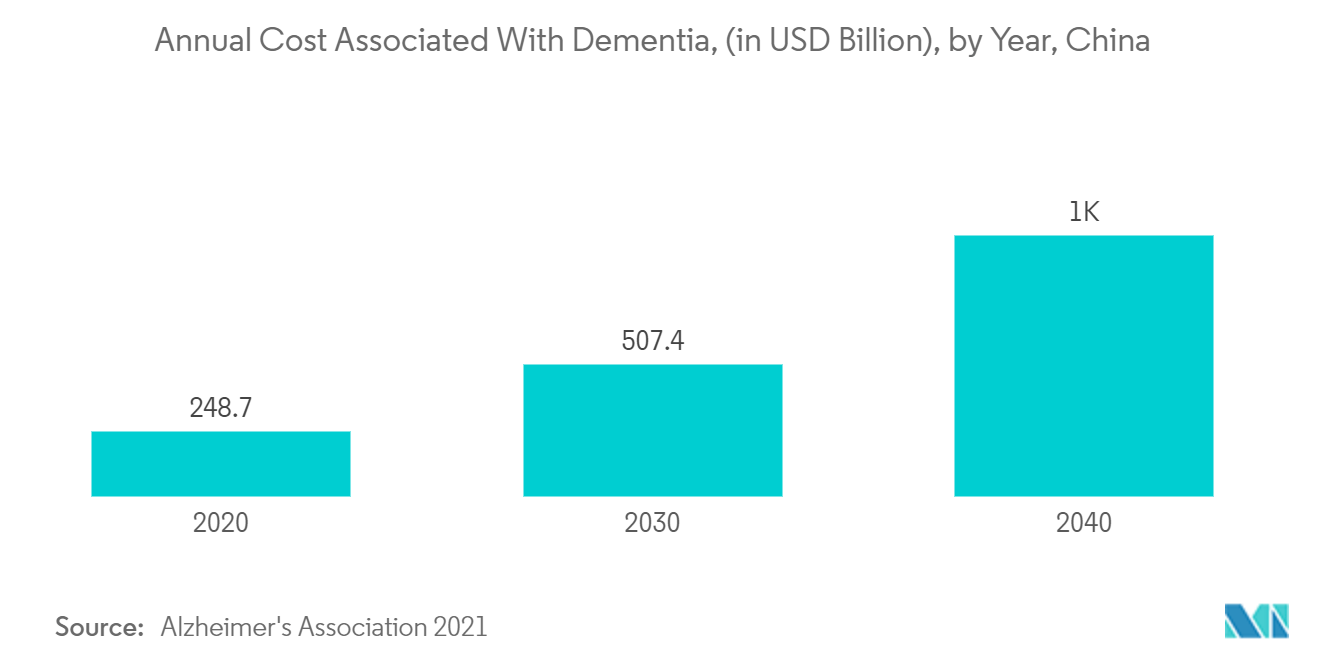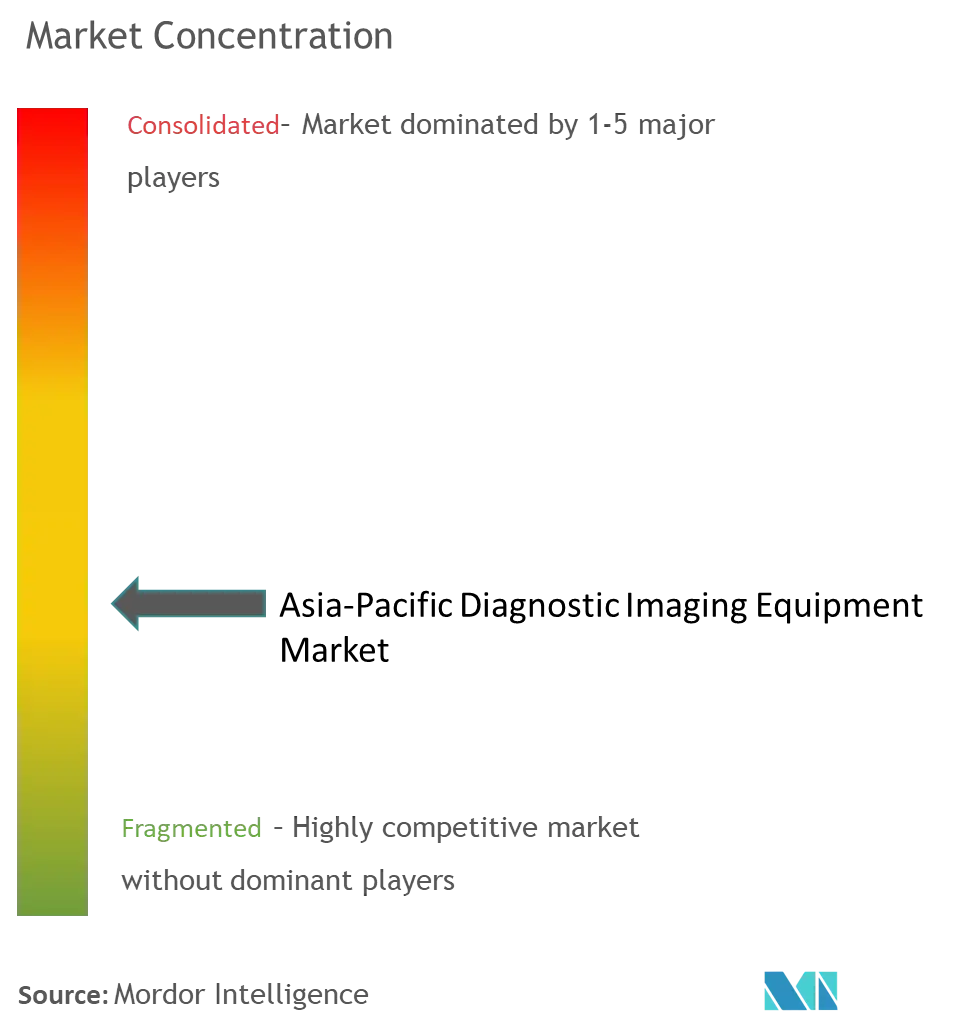APAC Diagnostics Imaging Devices Market Analysis
The Asia-Pacific Diagnostic Imaging Equipment Market is expected to register a CAGR of 7.5% during the forecast period.
The COVID-19 epidemic caused several significant problems for the healthcare sector. Since the majority of chronic therapies were considered non-urgent during the COVID-19 pandemic, all outpatient treatments were delayed or restricted to lower the danger of viral transmission. Lung imaging, however, became a significant component of COVID-19 diagnoses with the emergence of the infection, as it assisted in determining the severity of the illness in the afflicted population. According to a study published in the Indian Journal of Radiology and Imaging in January 2021, portable chest radiography had become a popular technique for rapidly assessing the degree of lung involvement in COVID-19 pneumonia in hospitalized symptomatic patients and calculating its progression. As a result, the use of diagnostic imaging grew during COVID-19 and had a favorable influence on the market. However, currently, the market has reached its pre-pandemic nature in terms of diagnostic imaging procedures and is expected to witness strong growth in the coming years.
Factors such as an increase in the prevalence of chronic diseases, technological advancements in imaging modalities, and the growing need for early diagnostics are driving the market.
There is a growing burden of life-threatening chronic diseases in Asian countries, which is one of the leading factors responsible for the market growth in the region. For instance, a research article by the National Institute of Health published in August 2021 highlighted in their research paper that both the prevalence and incidence of heart failure (HF) increase with increasing age and that HF places a considerable burden on health systems in China. Thus, the burden of cardiovascular diseases among the target populations in the countries of the Asia-Pacific region is expected to demand the availability of diagnostic imaging products for disease diagnosis and treatment. As a result, it is expected to contribute to market growth.
Furthermore, with the technological innovation in the area, many products are expected to be launched over the forecast period, which may also positively impact market growth. For instance, in April 2022, Wipro GE Healthcare announced the release of an innovative imaging solution that was entirely developed and produced in India. In accordance with the Atma Nirbhar Bharat mission, the imaging solution, the Revolution Aspire CT (computerized tomography) scanner, was produced at the recently opened Wipro GE Medical Devices Manufacturing unit. With the release of these new imaging devices in Asian countries, the market that was looked at is expected to grow quickly over the next few years.
However, the high cost of instruments and lack of skilled radiologists have been restraining the growth of this market.
APAC Diagnostics Imaging Devices Market Trends
Oncology Segment is Expected to Witness a Healthy Growth in Coming Years
Oncology is predicted to have considerable development in the country due to an increase in cancer incidence and technical advancements in the field of image diagnostics. According to statistics published by the Global Cancer Observatory (Globocan) in 2021, there were an estimated 206.60 million prevalent cases of cancer in five years for all types of cancer in both sexes in Asia during the year 2020. It was also reported that there are 9.73 million five-year prevalent cases of all types of cancer in males and about 10.86 million cases in females for the same year. Such a high prevalence of cancer in the region is generating the need for early diagnosis of cancer and thus driving the growth of the market.
Several key market players focusing on research and development of diagnostic imaging in Asia-Pacific are also aiding the growth of the market. For instance, in August 2021, Concord Medical Services Holdings Limited, which operates an extensive network of radiotherapy and diagnostic imaging centers in China, reported an investment of RMB 400.0 million (USD 62.2 million) in Concord Medical's subsidiary, Meizhong Jiahe Medical Science & Technology Development Group Co., Ltd. Additionally, in April 2022, Fujitsu and the Southern Tohoku General Hospital reported the launch of a joint research project with Fujitsu Japan Limited and FCOM Corporation on an AI technology for the early detection of pancreatic cancer from computed tomography (CT) scans without contrast agents (non-contrast CT scans).
Hence, an increased prevalence of cancer and the implementation of new technologies, along with research and development activities, are expected to help this segment register notable growth.
China is Expected to Hold a Significant Share in the Market and Expected to do Same in the Forecast Period
China is expected to grow quickly because chronic diseases are becoming more common, the number of older people is growing, and more advanced medical imaging equipment is being used.
More and more new products are being released and more money is being raised by Chinese diagnostic imaging companies.For instance, in August 2022, United Imaging Healthcare of Shanghai raised USD 1.6 billion on the very first day of its initial public offering as a public company. With the huge amount raised by United Imaging Healthcare of Shanghai, it is believed that the company will be investing a significant amount in innovative technologies, market expansion, or new product launches, which will ultimately contribute to the market's growth in the coming years.
Furthermore, there have been new facilities planned to become operational in the coming years in China, which will boost market growth. For example, Peking University announced in November 2022 that the National Biomedical Imaging Center, based in Beijing, will open in early 2023, with a construction area of 66,667 square feet.Peking University also stated that USD 237.33 million has been invested in this project. Hence, with such huge investments in medical imaging facilities, the market for diagnostic imaging equipment will be growing significantly over the forecast period in China.
Furthermore, Mindray, a global leader in the development and delivery of medical devices and solutions, announced the launch of its new general imaging, women's healthcare, and cardiology ultrasound solutions in May 2021.The Chinese company Mindray, with the launch of General Imaging Solutions, is contributing to the growth of the diagnostic imaging market in the country.
Furthermore, the increasing burden of neurological conditions in China is associated with the high demand for diagnostic imaging. For instance, Alzheimer's Association data published in November 2021 stated that the cost associated with dementia is on the rise in China and that the disease is posing a significant burden on the country's health system.
Thus, owing to the growing number of geriatrics in China, increasing investment in diagnostic imaging and new product launches are some of the crucial factors responsible for the market's growth.
APAC Diagnostics Imaging Devices Industry Overview
The major players in the Asia-Pacific diagnostic imaging equipment market include Carestream Health, Fujifilm Holdings Corporation, GE Healthcare, Hitachi Medical Corporation, Hologic, Inc., Koninklijke Philips N.V., Shimadzu Corporation, Siemens AG, Canon Medical Systems Corporation, and Shanghai United Imaging Healthcare Co., Ltd., among others. The leading vendors in the market are launching advanced diagnostic imaging equipment. These companies have also been involved in the acquisition of related healthcare companies in order to improve their product portfolio, geographical presence, and growth.
APAC Diagnostics Imaging Devices Market Leaders
-
Carestream Health
-
Fujifilm Holdings Corporation
-
Hologic, Inc
-
Koninklijke Philips N.V.
-
GE Healthcare
- *Disclaimer: Major Players sorted in no particular order
APAC Diagnostics Imaging Devices Market News
- October 2022: Luxonus Inc. received approval to market its photoacoustic 3D imaging system in Japan.
- February 2022: Siemens Healthineers and Universal Medical Imaging have signed a strategic collaboration agreement to help primary healthcare facilities in China improve the accuracy of their image screening and disease diagnosis using cutting-edge imaging diagnostic tools and remote scanning assistant equipment from Siemens Healthineers and the local medical imaging experts at Universal Medical Imaging.
APAC Diagnostics Imaging Devices Industry Segmentation
As per the scope of the report, diagnostic imaging is used to take images of the internal structure of the human body using electromagnetic radiation for an accurate diagnosis of the patient. Diagnostic imaging uses radiation to diagnose and treat diseases. The Asia-Pacific Diagnostic Imaging Equipment Market is segmented by product (MRI, Computed Tomography, Ultrasound, X-Ray, Nuclear Imaging, Fluoroscopy, and Mammography), application (Cardiology, Oncology, Neurology, Orthopedics, Gastroenterology, Gynecology, Other Applications), end-user (Hospitals, Diagnostic Centers, Others), and geography (China, Japan, India, Australia, South Korea, Rest of Asia-Pacific). The report offers the value (in USD million) for the above segments.
| By Modality | MRI | Low and mid field MRI systems (<1.5 T) | |
| High field MRI systems (1.5-3 T) | |||
| Very High, and Ultra High Field MRI Systems (3T and more) | |||
| Computed Tomography | Low End Scanners (~16-Slice) | ||
| Mid Range Scanners (~64-Slice) | |||
| High End Scanners (128-Slice and More) | |||
| Ultrasound | 2D Ultrasound | ||
| 3D Ultrasound | |||
| Other Types of Ultrasound | |||
| X-Ray | Analog Systems | ||
| Digital Systems | |||
| Nuclear Imaging | Positron Emission Tomography (PET) | ||
| Single Photon Emission Computed Tomography (SPECT) | |||
| Fluoroscopy | |||
| Mammography | |||
| By Application | Cardiology | ||
| Oncology | |||
| Neurology | |||
| Orthopedics | |||
| Gastroenterology | |||
| Gynecology | |||
| Other Applications | |||
| By End-User | Hospital | ||
| Diagnostic Centers | |||
| Other End-Users | |||
| Geography | China | ||
| Japan | |||
| India | |||
| Australia | |||
| South Korea | |||
| Rest of Asia-Pacific | |||
APAC Diagnostics Imaging Devices Market Research FAQs
What is the current Asia-Pacific Diagnostic Imaging Equipment Market size?
The Asia-Pacific Diagnostic Imaging Equipment Market is projected to register a CAGR of 7.5% during the forecast period (2025-2030)
Who are the key players in Asia-Pacific Diagnostic Imaging Equipment Market?
Carestream Health, Fujifilm Holdings Corporation, Hologic, Inc, Koninklijke Philips N.V. and GE Healthcare are the major companies operating in the Asia-Pacific Diagnostic Imaging Equipment Market.
What years does this Asia-Pacific Diagnostic Imaging Equipment Market cover?
The report covers the Asia-Pacific Diagnostic Imaging Equipment Market historical market size for years: 2019, 2020, 2021, 2022, 2023 and 2024. The report also forecasts the Asia-Pacific Diagnostic Imaging Equipment Market size for years: 2025, 2026, 2027, 2028, 2029 and 2030.
Our Best Selling Reports
Asia-Pacific Diagnostics Imaging Devices Industry Report
Statistics for the 2025 Asia-Pacific Diagnostic Imaging Equipment market share, size and revenue growth rate, created by Mordor Intelligence™ Industry Reports. Asia-Pacific Diagnostic Imaging Equipment analysis includes a market forecast outlook for 2025 to 2030 and historical overview. Get a sample of this industry analysis as a free report PDF download.







